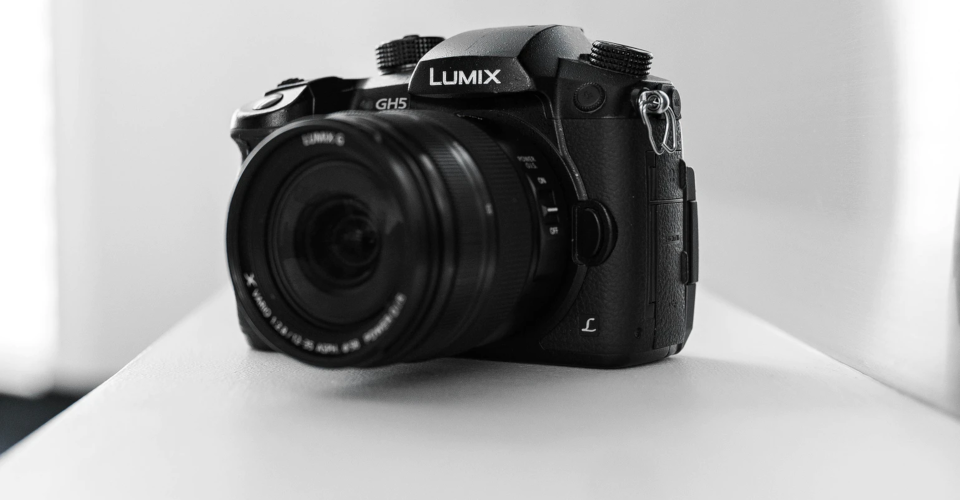6 Best Panasonic Prime Lenses in 2020
The Micro Four Thirds or MFT system has gained popularity among pros and amateur photographers for its accessibility, compact cameras, and excellent photo quality. Panasonic is at the forefront of its development, bringing out cameras and lenses that rival their larger counterparts in fidelity and performance.
Panasonic lenses are recognizable by their manual aperture rings and sleek black barrels. Photographers who use them can look forward to crisp images, excellent autofocus performance, and effective image stabilization not reliant on your camera. Primes are doubly interesting as they’re lighter and boast improved sharpness in comparison to zooms.
Here are the six best Panasonic prime lenses you can buy. We’ve covered everything from landscape to macro & wildlife photography, so finding your next prime should be a snap.
Note: MFT lenses have focal lengths that correspond to twice their value in full-frame terms. For example, if an MFT lens has a focal length of 12mm, it’s equivalent to 24mm on a full-frame camera. Panasonic teamed up with Olympus to develop the system. Every lens featured here also works well on Olympus cameras, except the AF ring.
| Budget |
|---|
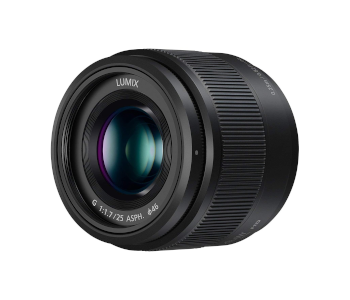 |
| Panasonic Lumix G 25mm f/1.7 |
| 4.3/5.0 |
| Type: Standard prime |
| Focal length: 15mm |
| No issues with distortion or vignetting. |
| Check Amazon |
| Best Value |
|---|
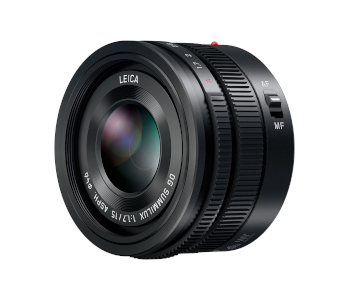 |
| Panasonic Leica DG Summilux 15mm f/1.7 |
| 4.6/5.0 |
| Type: Standard prime |
| Focal length: 15mm |
| This has excellent resistance to flares. |
| Check Amazon |
| Top Pick |
|---|
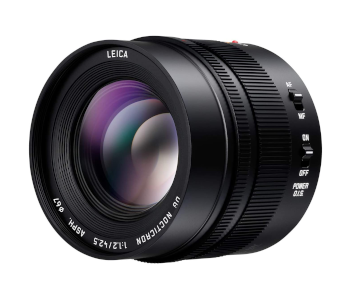 |
| Panasonic Leica DG Nocticron 42.5mm f/1.2 |
| 4.8/5.0 |
| Type: Portrait prime |
| Focal length: 42.5mm |
| Excellent for nighttime photography. |
| Check Amazon |
Panasonic Prime Lenses Comparison Table
| Image | Product | Overall Rating | Image quality | Build quality | Versatility | Price |
|---|---|---|---|---|---|---|
 | Panasonic Leica DG Nocticron 42.5mm f/1.2 | 4.8 | 4.9 | 4.8 | 4.7 | Check Price |
 | Panasonic Leica DG Summilux 15mm f/1.7 | 4.6 | 4.5 | 4.5 | 4.7 | Check Price |
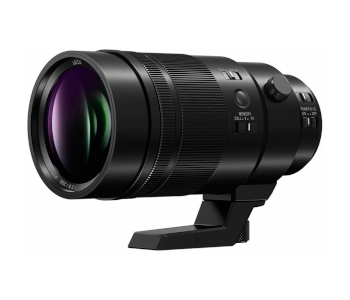 | Panasonic Leica DG Elmarit 200mm f/2.8 | 4.7 | 4.8 | 4.7 | 4.6 | Check Price |
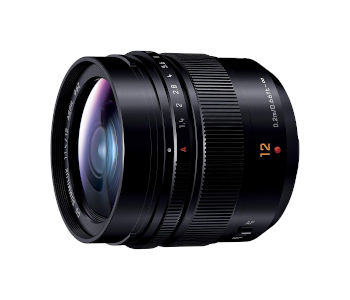 | Panasonic Leica DG Summilux 12mm F/1.4 | 4.5 | 4.6 | 4.4 | 4.4 | Check Price |
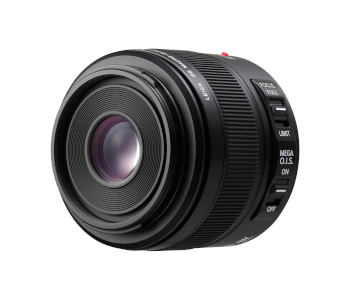 | Panasonic Leica DG Macro-Elmarit 45mm f/2.8 | 4.4 | 4.3 | 4.4 | 4.5 | Check Price |
 | Panasonic Lumix G 25mm f/1.7 | 4.3 | 4.3 | 4.2 | 4.4 | Check Price |
1. Best Overall – Panasonic Leica DG Nocticron 42.5mm f/1.2
Editor’s Rating: 4.8/5
Professional portrait photographers using MFT cameras are spoiled for choice since Olympus and Panasonic both provide exceptional primes. The latter’s Nocticron 42.5mm f/1.2 is a lens that’s hard to criticize. It sports uniform sharpness even at f/1.2, has no optical shortcomings, and is built to last a lifetime. It’s the best lens in Panasonic’s lineup and holds its own against world-class competition from Canon or Nikon as well.
Overview of Features
Superior build quality is the first thing you’ll notice about the Nocticron 42.5mm f/1.2. It’s made from a combination of lightweight metals and plastic designed to keep the lens free from dust and moisture while also ensuring structural integrity. It has a manual aperture ring that adjusts f-stops in thirds with a satisfying click. Unfortunately, the ring doesn’t work on Olympus cameras. You get a barrel-shaped metal hood that attaches to the lens via a thumbscrew.
The autofocus performs silently and nearly instantly, so it’s ready for use in movie making. The lens has a long minimum focus distance, which further cuts down on acquisition time. Manual focus is done by wire but feels smooth and satisfying as the ring is responsive. The Nocticron 42.5mm f/1.2 has optical image stabilization, allowing for long exposures and vivid nighttime photography.
Sharpness is fantastic from the get-go as the Nocticron 42.5mm f/1.2 exhibits even results when wide open. Decreasing the aperture nets small gains overall until f/2. Then it ramps up significantly until peaking at f/4 for the center and f/5.6 for the corners. Stepping down further leads to minimal fidelity loss until you get to f/16.
The Nocticron 42.5mm f/1.2 is one of the most optically sound lenses we’ve ever reviewed. You’d think that vignetting would be a severe issue, but it shows only 1.5 stops at f/1.2. A remarkable result for a portrait prime. Barrel distortion clocks in at 0.3 percent and is therefore irrelevant, as is the maximum width of 0.5 pixels chromatic aberration can reach. Shooting into the sun results in minimal contrast loss. The blur the lens is capable of producing is exceptionally smooth.
What We Didn’t Like
The Nocticron 42.5mm f/1.2 has no substantial flaws. It’s bulky in MFT terms and won’t balance well on smaller cameras. It’s also pricey, but its image quality makes this a non-issue for professional use.
| Tech Specs |
|---|
| Dimensions: 2.9 x 2.9 x 3” |
| Weight: 15 oz |
| Type: Portrait prime |
| Focal length: 42.5mm |
| Maximum aperture: f/1.2 |
| Minimum aperture: f/16 |
| Minimum focus distance: 1.6’ |
| Angle of view: 29° |
| Image stabilization: Yes |
| Pros |
|---|
| Exceptional sharpness |
| Great build quality |
| Free from distortion and chromatic aberration |
| Excellent for nighttime photography |
| Cons |
|---|
| Doesn’t balance well on small MFT cameras |
| Expensive |
2. Best Value – Panasonic Leica DG Summilux 15mm f/1.7
Editor’s Rating: 4.6/5
30mm lenses are often overlooked but versatile as their focal length works well for landscape, product, or group portrait photography. The Summilux 15mm f/1.7 has a fast aperture, reliable autofocus, and excellent optics to back its focal range up. Add to that an appealing price tag, and you’ve got one of the most interesting MFT lenses not just from Panasonic, but in general.
Overview of Features
The Summilux 15mm f/1.7 is considerably smaller and lighter than our overall winner, fitting comfortably on MFT cameras of any size. Its Leica branding indicates the highest quality, and that’s what you’re getting in its lightweight yet robust construction. A nicely damped focus ring is joined by another for manual aperture selection. A switch on the side toggles between manual and automatic focus. The mount and lens hood are both metal.
A fast aperture allows the Summilux 15mm f/1.7 to focus rapidly regardless of light. Its accuracy isn’t perfect, but the lens will faithfully track subjects nine out of ten times and do so quiet enough for video. A minimum focusing distance of eight inches allows you to get up close to food or tech gear. This makes the Summilux 15mm f/1.7 a great choice if you’re into reviews r tutorials. Image stabilization is absent, which isn’t surprising given the lens’s focal length.
Central sharpness is already great at f/1.7, with the corners trailing behind a step. They quickly start gaining ground and catch up as you hit f/5.6. There’s no field curvature, and narrowing the aperture only has a negative impact on image quality at f/16.
The Summilux 15mm f/1.7 delivers pleasing bokeh with no trace of onion rings. Chromatic aberration is strongest when wide open, but it doesn’t exceed half a pixel even then. The lens has commendable flare resistance since shooting into the sun barely affects contrast, let alone image quality.
What’s Bad About It?
The Summilux 15mm f/1.7 shows high amounts of barrel distortion. That’s unusual for a lens of this focal length. Avoid using it for situations when it’s important to keep lines straight, like for architecture photos. You can also correct for the distortion in software like Lightroom. There’s two stops of light falloff at f/1.7. Adjusting the aperture or using Lightroom will fix it.
| Tech Specs |
|---|
| Dimensions: 2.3 x 2.3 x 1.4” |
| Weight: 4.1 oz |
| Type: Standard prime |
| Focal length: 15mm |
| Maximum aperture: f/1.7 |
| Minimum aperture: f/16 |
| Minimum focus distance: 7.9” |
| Angle of view: 72° |
| Image stabilization: No |
| Pros |
|---|
| Excellent value for the money |
| Versatile focal length |
| Autofocus speed not affected by dim light |
| Excellent resistance to flares |
| Cons |
|---|
| Pronounced barrel distortion |
| Some vignetting at f/1.7 |
3. Panasonic Leica DG Elmarit 200mm f/2.8
Editor’s Rating: 4.7/5
You’ll need a powerful telephoto lens to take pictures of skittish squirrels or a pride of lions from a safe distance, and the Elmarit 200mm f/2.8 is the finest MFT has to offer. It’s an immaculately crafted lens designed to deliver tack-sharp photos of far-away subjects with speed and precision. Its price is not for the faint of heart, but the images this lens captures are more than convincing.
Overview of Features
The Elmarit 200mm f/2.8 is massive for an MFT lens yet remarkably small for what translates to a 400mm prime in full-frame terms. It’s heavy, too, and fortunately comes with a fantastic tripod collar that’s easy to adjust for vertical and horizontal shooting. The lens is weather-sealed and freezeproof, allowing you to brave the harshest environments for award-winning photos.
Autofocus performance is stellar as the Elmarit 200mm f/2.8 takes only a moment to find and stick to its prey. A focus limiter switch lets you speed it up even more by setting the minimum focusing distance to 3m. There’s also a switch that will recall a memorized focus position for quick access at any time. Next to it is a function button you can map various camera settings to for easier access. The lens has exceptional image stabilization, averaging six stops of correction in field tests.
The Elmarit 200mm f/2.8 isn’t the world’s sharpest telephoto, but it’s not far off. Central sharpness is excellent throughout its aperture range, reaching the top at f/4 and remaining usable until f/16. The edges & corners are slightly weaker at first and catch up by f/8. F/22 is the only setting we wouldn’t recommend as diffraction takes a toll on detail.
A focal length of 400mm in full-frame terms translates into impressive depth of field and razor-thin focus at f/2.8. The bokeh is breathtaking, while foreground & background blur is among the smoothest we’ve seen. Pincushion distortion is so small as not to be a problem, and chromatic aberration is only noteworthy in that it’s absent. Even light falloff is barely visible at f/2.8 and only noticeable if you’re photographing scenes with a single dominating color.
Are There Drawbacks?
The Elmarit 200mm f/2.8 is by far the most expensive lens on review, costing more than twice as much as our winner. However, its price needs to be put into perspective. Similar lenses for full-frame cameras cost two to three times as much, which makes this one a steal.
| Tech Specs |
|---|
| Dimensions: 3.4 x 3.4 x 6.9” |
| Weight: 2.8 lbs |
| Type: Telephoto prime |
| Focal length: 200mm |
| Maximum aperture: f/2.8 |
| Minimum aperture: f/22 |
| Minimum focus distance: 3.8’ |
| Angle of view: 6.2° |
| Image stabilization: Yes |
| Pros |
|---|
| Exemplary build quality and weather sealing |
| Nearly instant autofocus & focus memory |
| Impressive image stabilization |
| Balanced optics |
| Cons |
|---|
| Expensive for an MFT lens |
4. Panasonic Leica DG Summilux 12mm F/1.4
Editor’s Rating: 4.5/5
The Summilux 12mm F/1.4 is the brightest wide-angle lens MFT has to offer and an ideal choice for landscape, interior, architecture, or city photography. It’s built to exacting standards and has unreal central sharpness. Add superb flare resistance, and you’ve got a lens that delivers stunning outdoor images every time.
Overview of Features
The Summilux 12mm F/1.4 is unusual for a lens of its caliber in that it’s small yet heavy. That’s due to its solid construction and 15 glass elements in 12 groups. These include extra-low dispersion as well as aspherical glass that tackles artifacts and CA. The lens is billed as dust-and splashproof, so you can leave it out in the rain and not worry about getting any of it inside your camera.
You’ll love the Summilux 12mm F/1.4 if you’re a moviemaker, as any sound it makes while focusing will be drowned out by background noise. Its response times are respectable and decrease only slightly as lighting conditions become more challenging. Manual focusing is precise and smooth thanks to a broad, ridged ring that’s a pleasure to handle.
Panasonic built the Summilux 12mm F/1.4 with a singular purpose – to deliver the best central image quality on MFT cameras. It succeeds brilliantly as the center is impressive even at f/1.4. The quality continues to soar until f/4, when it starts dropping mildly. It’s worst at f/16, but we’d hardly call it low.
Artifacts and ghosting are a non-issue with this lens. You can comfortably use it without the supplied lens hood to get unobstructed wide-angle shots in direct sunlight. Barrel distortion is within acceptable limits, as is the amount of CA throughout the frame. Backgrounds are pleasingly blurry, especially for a lens of this type. There’s some vignetting that has minimal impact on image output.
What We Didn’t Like
The Summilux 12mm F/1.4’s edges aren’t soft, but their quality is noticeably worse than the center’s. This is another lens with a high price tag, given the accessibility of MFT cameras.
| Tech Specs |
|---|
| Dimensions: 2.8 x 2.8 x 2.8” |
| Weight: 11.8 oz |
| Type: Wide-angle prime |
| Focal length: 12mm |
| Maximum aperture: f/1.4 |
| Minimum aperture: f/16 |
| Minimum focus distance: 7.9” |
| Angle of view: 6.2° |
| Image stabilization: No |
| Pros |
|---|
| World-class central sharpness |
| Impressive flare resistance |
| Resistant to dust and moisture |
| Quick autofocus barely affected by low light |
| Cons |
|---|
| A bit pricey |
| Edge sharpness lags behind the center |
5. Panasonic Leica DG Macro-Elmarit 45mm f/2.8
Editor’s Rating: 4.4/5
Need a dependable macro lens that functions as an excellent portrait prime too? In that case, getting the Macro-Elmarit 45mm f/2.8 is a no-brainer. It has one of the best autofocus systems we’ve seen on a macro lens and is remarkably small for having both image stabilization and true 1:1 magnification. The alternative from Olympus might be better if you insist on maximum sharpness. Panasonic’s lens is excellent otherwise.
Overview of Features
The Macro-Elmarit 45mm f/2.8 is notable for its size and weight, especially since there’s a complex glass array inside. Its ten groups are further segmented into three floating sections. One element is even aspherical, which is unusual for macro lenses. The lens is tightly constructed and easy to use. It comes with a uniquely-shaped rectangular hood that works well but can’t be reversed.
Autofocus performance is the best thing about the Macro-Elmarit 45mm f/2.8. Most macro photographers favor manual focusing, but pairing the lens with a G-series Panasonic camera lets you designate precise focus points throughout the frame. That causes the lens to respond rapidly and reliably. We wouldn’t recommend it for movies, though, as the AF isn’t silent and the OIS rattles until you turn your camera on. Speaking of image stabilization, it provides a middling three stops of compensation.
There’s no getting around it; the Macro-Elmarit 45mm f/2.8 is soft at f/2.8. Fortunately, the lens rallies at f/4 with good results across the frame. There’s a slight overall increase in quality at f/5.6 before reaching uniformity at f8 as the small advantage the center had over its periphery disappears. We wouldn’t advise using f/22; everything else is fair game.
Distortion is absent, which is something you should expect from a quality macro lens. The bokeh is soft and swirly, exhibiting the cat’s eye shape at the corners of the frame. Vignetting never exceeds 1.2 stops and isn’t problematic. Neither is lateral CA, which doesn’t require in-camera correction to maintain barely noticeable levels.
What’s Bad About It?
The Macro-Elmarit 45mm f/2.8 isn’t as resistant to flare as other cameras on review. You can get away with shooting towards the light with negligible contrast loss. However, you shouldn’t shoot into it since this produces veiling flare and noticeable artifacts.
| Tech Specs |
|---|
| Dimensions: 2.5 x 2.5 x 2.4” |
| Weight: 15 oz |
| Type: Macro lens |
| Focal length: 42.5mm |
| Maximum aperture: f/2.8 |
| Minimum aperture: f/22 |
| Minimum focus distance: 5.9” |
| Angle of view: 27° |
| Image stabilization: Yes |
| Pros |
|---|
| Excellent autofocus for a macro lens |
| No distortion |
| True 1:1 magnification in a compact body |
| Few vignetting and CA issues |
| Cons |
|---|
| Soft at f/2.8 |
| Poor flare resistance |
6. Best Budget Option – Panasonic Lumix G 25mm f/1.7
Editor’s Rating: 4.3/5
The “nifty fifty” is a popular choice as the first purchase after mastering your kit lens, and the Lumix G 25mm f/1.7 comes highly recommended. It has the build quality, optical performance, and picture fidelity of lenses that cost considerably more. There’s no better budget pick for Panasonic MFT users when it comes to versatility and practicality.
Overview of Features
The Lumix G 25mm f/1.7 is a lightweight and compact prime you have no reason not to take on any kind of photoshoot due to the normal perspective it provides. The barrel is made from quality plastic. Its metal mount slots easily into cameras while keeping moisture and dust at bay. Construction is basic as there are only eight elements in seven groups. There are no controls or special features on the outside of the barrel other than the decorative ring. The lens isn’t weather-sealed, but that’s to be expected at this price point.
The motor that drives the Lumix G 25mm f/1.7’s autofocus does a commendable job. It’s slower than some and prone to hunting in low light but performs accurately and nearly silently otherwise. Focusing doesn’t cause the lens to extend, meaning you can attach ND filters or polarizers to its 46mm thread. Manual focusing is done by wire, and the ring is ribbed for comfortable handling.
The Lumix G 25mm f/1.7 performs well in sharpness tests, scoring respectably in central detail from the get-go. We were even more impressed with its edge performance since the periphery is never far behind and even manages to catch up with the center at f/4. Central sharpness remains high until f/11 when both values start to drop significantly because of diffraction.
Barrel distortion clocks in at just 0.3 percent and won’t be noticeable unless you take pictures of buildings with lots of parallel lines. The lens can produce a shallow depth of field and isolate subjects against a backdrop of smooth transitions & creamy bokeh. Light falloff isn’t concerning, and the only time you’ll notice a hint of chromatic aberration is when you shoot highly-contrasting scenes.
Are There Drawbacks?
The Lumix G 25mm f/1.7 is the second lens on review that doesn’t handle flaring well due to the lack of multiple dispersive glass elements. It’s best not to include the sun in your composition as this sharply decreases contrast and leads to lots of artifacts. Some samples may produce a grinding noise while focusing in either mode. You can ask for a replacement if yours does this too, though.
| Tech Specs |
|---|
| Dimensions: 2.4 x 2.4 x 2.1” |
| Weight: 4.4 oz |
| Type: Standard prime |
| Focal length: 15mm |
| Maximum aperture: f/1.7 |
| Minimum aperture: f/22 |
| Minimum focus distance: 9.8” |
| Angle of view: 47° |
| Image stabilization: No |
| Pros |
|---|
| A well-rounded lens at an amazing price |
| Sharp across the board |
| No issues with distortion or vignetting |
| Pleasant background blur |
| Cons |
|---|
| Poor flare resistance |
| Quality control issues |
Contents
- Panasonic Prime Lenses Comparison Table
- 1. Best Overall – Panasonic Leica DG Nocticron 42.5mm f/1.2
- Overview of Features
- What We Didn’t Like
- 2. Best Value – Panasonic Leica DG Summilux 15mm f/1.7
- Overview of Features
- What’s Bad About It?
- 3. Panasonic Leica DG Elmarit 200mm f/2.8
- Overview of Features
- Are There Drawbacks?
- 4. Panasonic Leica DG Summilux 12mm F/1.4
- Overview of Features
- What We Didn’t Like
- 5. Panasonic Leica DG Macro-Elmarit 45mm f/2.8
- Overview of Features
- What’s Bad About It?
- 6. Best Budget Option – Panasonic Lumix G 25mm f/1.7
- Overview of Features
- Are There Drawbacks?

